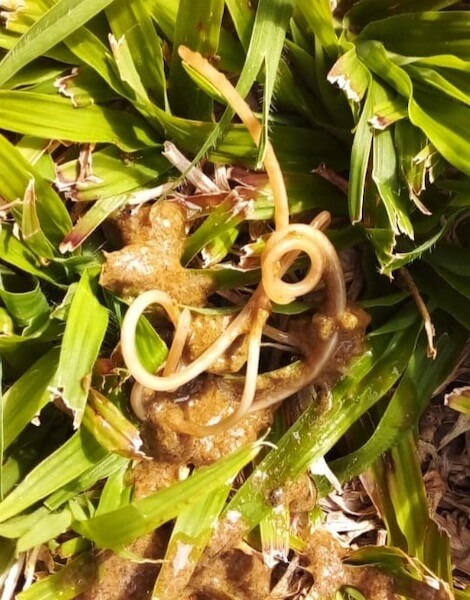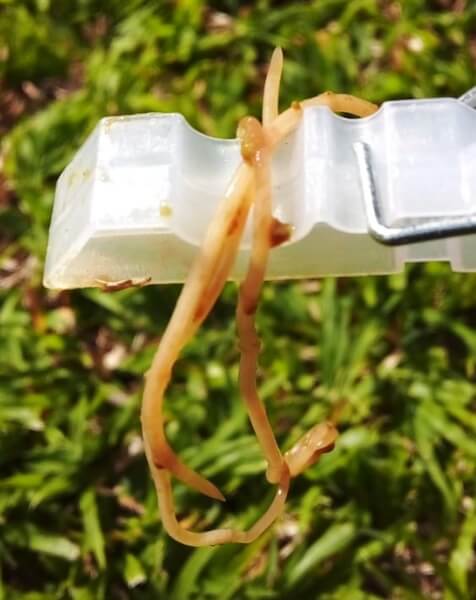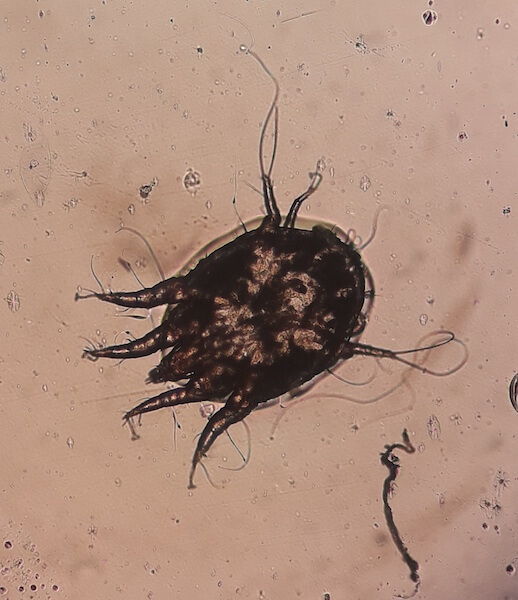Just the thought of them makes us itch!
Endo- (“inside”) and ecto- (“outside”) parasites are very common, everyday causes of itching in dogs and cats. Ears, bottoms and everything in between can be affected by the pesky creepy crawlies.
In this post, we will look at some of the most common endoparasites and ectoparasites we find in general practice, as well as very briefly discuss the various parasites we find in each group.
Internal parasites
Endo- (or internal) parasites live in the intestinal tract of their host. They can cause a lot of misery and sickness for infected pets.
Common endoparasites and symptoms
The most common intestinal parasites are:
- Roundworm
- Hookworm
- Tapeworm
- Coccidia
These can cause:
- Inflammation of the intestinal tract
- Diarrhoea
- Anaemia
- Perianal irritation, or irritation in the tissue around the anus.
How does the infection happen?
Pets can become infected with endoparasites in many different ways. They can get it from digging in the soil, catching rodents, eating an illicit snack, or playing with another pet who is infected. Endoparasites are also often passed on from animal moms to their babies at birth.
Diagnosis
Your vet will obtain or request a faecal sample from your pet to diagnose endoparasite problems. From this useful poo sample, we will do three tests – a faecal flotation test, a wet prep, and a faecal smear.
Recognising the signs
Roundworm (Toxacara)
Toxocara canis, or roundworm for dogs, is the most common type of internal parasite causing trouble in puppies. The parasites use the nutrients in the puppy’s intestines, causing malnourishment, emaciation and diarrhoea. The typical “roundworm-infected puppy” look is skinny and pot-bellied.
Roundworm for cats (Toxocara felis) can cause diarrhoea in cats too. It has a similar effect to roundworm in dogs – you may see malnourishment, skinniness and a swollen belly.
Roundworm can affect adult dogs and cats, but you will probably not notice any ill effects if your adult pet is infected. Adult pets can shed parasite eggs in their stool, infecting puppies and kittens when they come in contact with their rear end or their faeces.
Solution: a routine dewormer is very effective in controlling roundworm. It is advisable to administer routine dewormers monthly for puppies and kittens until they are 4-6 months old, and every 3-4 months for pets older than 6 months.


Hookworm (Ancylostoma)
Hookworm in dogs and cats can cause serious, bloody diarrhoea. This can happen to any pet, but is especially common in puppies and kittens.
Sadly, hookworm can be life-threatening. The parasite has sharp mouth parts that “hook” onto the intestinal wall, causing inflammation, trauma and bleeding. In severe cases it can also cause anaemia – look out for pale gums in your pet.
Solution: a routine dewormer is very effective in controlling hookworm.
Whipworm (Trichuris)
Whipworm is yet another type of internal parasite that attaches itself to the host’s intestinal wall. It can cause severe irritation to the large intestinal lining, and result in watery, bloody diarrhoea, weight loss and emaciation.
Cats and dogs of all ages are susceptible to whipworm, but puppies get infected the most often.
Solution: whipworm is also reliably controlled by routine dewormers.
Tapeworm (Echinococcus and Taenia sp.)
There are several species of tapeworms that can live in dogs and cats. If your pet is infected with this parasite, you may notice “rice grain-like” parasite segments in your companion’s faeces.
A species of tapeworm known as Echinococcus granulosis can also affect humans, causing nausea, pain, and other symptoms. This means that tapeworm carries extra significance as a zoonotic disease.
Solution: not all dewormers will kill tapeworms. It needs a very specific effective active ingredient. Happily, the routine dewormers that we currently use in our practice are highly effective against tapeworm.
Coccidia
Coccidia are common protozoan parasites, or simple one-celled parasitic species. There are several different species of coccidia affecting a multitude of animal species, from dogs and cats to chickens and lambs.
Coccidia can cause severe and debilitating diarrhoea, especially in puppies and kittens. The stools of an infected pet are watery and sometimes even bloody. As with most other internal parasites, infected adult animals can seem completely unaffected, but can spread the parasite via their faeces.
Solution: there is now a very effective anti-coccidial treatment licenced for dogs and cats.
Giardia
This very common parasite is also a protozoa, or simple one-celled species. It can cause disease in both animals and humans.
The Giardia life cycle has two different phases, and it is important to be aware of both. The fragile trophozoite form of the parasite lives inside the gut, where it sheds the hardy cystic form, which can survive for long periods in wet conditions and boggy areas in your garden. When your pet swallows a cyst, the cyst transforms to a trophozoite and attaches itself to the intestinal wall to feed.
The damage done by the Giardia parasite causes acute, foul-smelling, watery, and sometimes bloody diarrhoea. The diarrhoea may be intermittent. Giardia can also cause vomiting and weight loss. Healthy adult dogs can be infected but completely asymptomatic.
Solution: antibiotics are effective at treating Giardia, so a course of antibiotics may be prescribed.
External parasites
Ecto- (or external) parasites live on the skin surface or in the hair follicles of their host. They can be uncomfortable and irritating to both pets and their owners, and a catalyst for more serious conditions.
Common ectoparasites and symptoms
The most common ectoparasites are:
- Fleas
- Ticks
- Lice
These can cause:
- Itching
- Dry, patchy coats
- Painful, raw patches of skin
- Allergies
- Bacterial infections.
How does the infection happen?
External parasites are most often passed on via contact with another infected animal. Indirect contact can cause problems too, as an empty field or vacated building may contain parasites for many months after the previous hosts have left.
Recognising the signs
Fleas
Not only are fleas annoyingly itchy; they are also a common cause of allergic dermatitis. Many cats and dogs are allergic to flea saliva.
If your pet is super itchy and has a sparse hair coat, these are good “indicators” of a flea problem in your house! You may also find a black “grit” of flea droppings on your pet’s coat, especially on the back, tail base, and under the chin. Even if you cannot find a live flea, flea droppings are a good enough reason to believe there is a “passenger” on your furry friend.
Solution: nowadays there are excellent defleaing treatments available for your pet. Do not forget about their bedding and the rest of the house – fleas lay their eggs on bedding, carpets, and even wood skirting boards, so be sure to treat these with an effective household spray too.
Ticks
Ticks are infamous for causing life-threatening diseases in their hosts. However, there are quite a few tick species that can latch onto your tail-wagging walking companion, and not all of them cause serious diseases in dogs.
- “Cattle ticks” can be simply itchy, and maybe cause some inflammation or a bacterial granuloma.
- A handful of tick species, such as Haemaphysalis leachi (the Yellow Dog tick) and Rhipicephalus sanguineus (the Brown Dog tick) can cause serious illness like tick bite fever.
Unlike other external parasites, ticks are relatively large and easy to spot. Simply part your dog or cat’s fur to examine their skin, or pet them thoroughly and try to feel for any lumps under the fur.
If your furry friend has recently been bitten by a tick, and you notice that he or she is lethargic, feverish, or uninterested in food, your pet may have tick bite fever. It’s crucial to contact a vet as soon as possible.
More on this coming soon in another blog post!
Solution: many good defleaing treatments also keep ticks at bay. It helps to examine your pets after a walk in the field, and remove any ticks by grasping and pulling the tick at the spot where it enters the skin (making sure no tick mouthparts are left behind), using a pair of tweezers. Should your pet already be on a good, reputable tick treatment, it will be best to leave the ticks alone to fall off by themselves. If your pet has tick bite fever, your vet may prescribe antibiotics.
Lice
Lice are tiny, but visible to the naked eye. These crawlies live in the hair or feathers of pets. To spot lice, part the hair or feathers and look carefully – you will see very tiny grey spots slowly moving around.
Biting or chewing lice feed on sloughing skin cells and secretions, and blood-sucking lice attach themselves to the skins of their hosts and feed from their blood. Sucking lice cause small wounds that can become infected, and both types cause severe itching, a rough, dry coat, and hair loss due to the constant scratching, biting and rubbing of their host.
Solution: there are several good topical treatments that are highly effective at eradicating lice. These will be available at your local veterinary practice. Keep in mind that most lice treatments do not affect lice eggs, so the treatment may need to be repeated consistently over several months. To avoid re-infection, your pet’s bedding and collar should be washed thoroughly, and any grooming tools should be replaced.
Mites
We have probably all seen fleas, ticks and maybe lice, but the presence of mites can go undetected by the naked eye. The three most common mites we encounter at our practice are Demodex (mange mite), Sarcoptes (scabies), and Otodectes (ear mites).
It is important to note that a few mites are common on any healthy animal (and human!). As long as the pet’s immune system is healthy, these mites cause no harm. However, the immune system may be less effective in puppies and immune-compromised adults. If the immune system does not keep the mite numbers under control, they multiply and become out of hand.
For this reason, mange is very prevalent in informal settlements where free-roaming dogs are often malnourished or sick. Demodex mange mites live in the hair follicles of their host, causing the hair to fall out. Demodectic mange is not necessarily an itchy condition, but where there is a secondary bacterial infection, it can cause a severe itch. On the other hand, Sarcoptic mange (scabies) is a severely itchy condition and causes extreme reactions of scratching, biting and rubbing.

There are different types of ear mites, and the Otodectes cynotis species is by far the most common type found in dogs, cats and rabbits. It is highly contagious and therefore often seen in multiple kittens or puppies in a litter where there has been close physical contact between littermates.
Otodectes cynotis lives in the ear canal, and causes:
- ear irritation,
- scratching of the ears,
- head shaking,
- a waxy or crusty discharge from the ear,
- hair loss around the ears due to scratching,
- a crusty rash around the ear, or even
- an aural haematoma (large blood blister in the ear flap) due to excessive head shaking and scratching.
Solution: there are several highly effective topical treatments available for eradicating mites. These may be daily washes or single-use treatments.
Peaceful prevention
Thanks to modern medicine, it is no longer necessary to live with the pain and discomfort that parasites bring. Most parasite infections can be sorted out before they really manage to gather momentum and cause issues. In fact, parasites can be prevented from finding a home on your furry or feathered friend in the first place! So please, chat with us about parasite prevention options at your pet’s next checkup.
Some parasites are worthy of their own write-up. Look out for future posts on the most dangerous culprits and the diseases they can cause!











